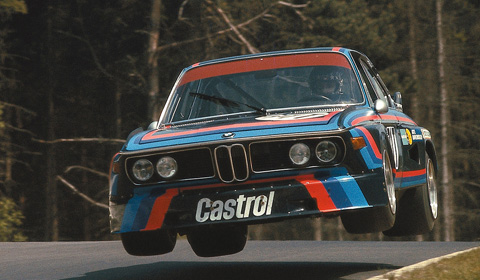
BMW Motorsport has started. In this second part of the history of BMW M we will take a look at the BMW 3.0 CSL, which propelled the German manufacturer immediately to victory.
In order to succeed in racing BMW convinced Jochen Neerpasch, former Porsche driver and in and Ford’s racing manager in Cologne, to come to Munich. Neerpasch immediately attraced a whole group of talented and successful racing drivers like Chris Amon, Toine Hezemans, Hans-Joachim Stuck and Dieter Quester.
One year later BMW unveiled the 3.0 CSL, a homologation special built to make the car eligible for racing in the ETCC. The ‘L’ in the car’s name refers to ‘lightweight’. This car had an overall weight of 1,092kg due to the doors and lid made of aluminium, and a lightweight interior with perspex side windows. The car was initially powered by a six-cylinder engine with twelve valves which delivered 340hp, but throughout the years displacement and the amount of power grew. The 3.0 CSL was the first BMW featuring the three blue, violet and red colours stripes on a white background, the official racing colour of the Bavarians.
The 3.0 CSL was an instant success in the ETCC. BMW regarded 1973 as their kick-off year, so they didn’t expected to be victorious from the start. The debut race at Monza was won by Niki Lauda and Brian Muir in the Alpina BMW 3.0 CSL. Toine Hezemans drove together with Dieter Quester to a overall victory at the 24-hours of Spa-Francorchamps, and they also won their class at Le Mans. But at the German Touring Car Grand Prix at the Nürburgring, which was also won by BMW, a new upgrade which would make this car famous made its debut.
First, the displacement of the 3.2 liter engine was increased to 3.5 liter, the output also increased to 375hp. Second, the four-speed gearbox by ZF was replaced by a Getrag five-speed gearbox. Third, the weight of the car decreased by 150kg. But the most noticeable upgrade was the new aerodynamic package, which included a large front air dam, short fins running along the front fenders, a spoiler above and behind the trailing edge of the roof, and a tall rear wing. Quite remarkable these package was deemed illegal for road use by the German authorities, so BMW sold the car with the package nicely enclosed in the trunk, ready for installation by the owner. Thanks to its rear wings, the 3.0 CSL became known as the Batmobile.
The rest of the 1973 was successful as well with BMW winning the Zandvoort Trophy, the six hours of Paul Ricard and the race at Silverstone. At the end Toine Hezemans and BMW Motorsport secured the European Touring Car Championship. By the end of the season the amount of horsepower was increased to over 400. Developments and successes continued as 3.0 CSLs would win the European Touring Car Championship again in every year from 1975 to 1979. Eventually, at the end of its career the 3.0 CSL developed a maximum output of 800 horsepower. Also interesting is the fact that the first two BMW Art Cars were 3.0 CSLs, the first was painted by Alexander Calder and the second by Frank Stella.
The Batmobile entered the stage like a true superhero. But BMW had already begun working on an even more iconic car, but that is another story which will be told very soon.
[References: Conceptcarz and RTL GP Magazine, number 01/2012]











































I’ll bet the next will be my absolute favorite of the Bimmer M series
The M1